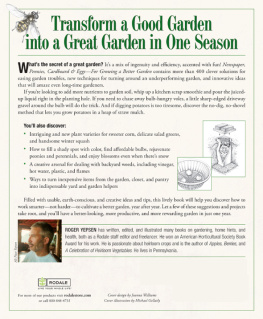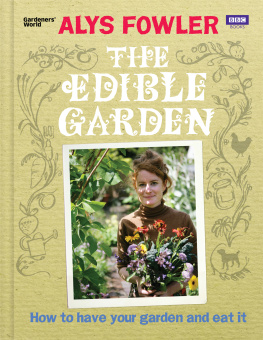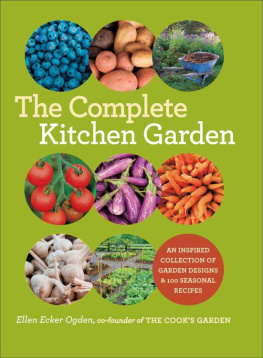INTRODUCTION
Speedy Transformations
Gardening is something like professional sports. At the end of the season, you evaluate what went right, what went wrong, and what might make things better next year. The goal for next years garden might be a more bountiful harvest of vegetables, or an impressive display of artfully arranged perennials. You may want to garden more efficiently, to free up time for other warm-weather activities. Whatever your particular bent, this book offers a generous range of ideas on getting better performance from your garden. Youll find new wrinkles, as well as variations on familiar themes such as coaxing seeds to sprout and dealing with pests and diseases.
The bottom line isnt only to produce more and toil less, but also to reap more enjoyment from your time out in the garden. Few of us really have to get out there and put in a few hours a day. Working in the yard is an elective activity (aside from obeying local weed ordinances, that is), and the more pleasure you take from it, the more care youre apt to invest. Thats why especially helpful tips often are those that appeal to our sense of wonder. The most enthusiastic gardeners seem to be those who are curious, taking note of what works best.
In the chapters that follow, youll find a mix of quick fixes, weekend projects, and intriguing plants that can give your garden a lift no matter what you grow or how many hours you care to invest. In the process, you may find that your very good garden is on its way to becoming a great gardenone that will welcome you each time you step out into the yard.
 , Seed Starting and Saving, tells how to enjoy the astounding variety of plants available only as seed, while saving money over buying plants. Starting from seed also allows you to plan for a midseason planting that will yield a late crop of vegetables or flush of flowers, at a time of year when nurseries are running out of stock and gardeners tend to run out of enthusiasm. And youll save substantially over what youd spend for plants.
, Seed Starting and Saving, tells how to enjoy the astounding variety of plants available only as seed, while saving money over buying plants. Starting from seed also allows you to plan for a midseason planting that will yield a late crop of vegetables or flush of flowers, at a time of year when nurseries are running out of stock and gardeners tend to run out of enthusiasm. And youll save substantially over what youd spend for plants.
 The most challenging stage in a young plants life is adapting to the great outdoors. , Planting and Transplanting, offers approaches for easing this transition. Tips include using colored mulches that researchers have found to boost plant performance; gardening with elevated beds to bring the plants up to your level, rather than the other way around; and succeeding with inexpensive bare-root plants.
The most challenging stage in a young plants life is adapting to the great outdoors. , Planting and Transplanting, offers approaches for easing this transition. Tips include using colored mulches that researchers have found to boost plant performance; gardening with elevated beds to bring the plants up to your level, rather than the other way around; and succeeding with inexpensive bare-root plants.
, Soil, Compost, and Fertilizing, for ideas on making the most of the organic gardeners greatest ally, good soil. Compost, proper pH, nutrients, and custom fertilizer blends.
 Weeds happen, unless you are growing fungi in a cave, and , Weeds and What to Do about Them, shows how to meet this challenge with a creative arsenal that includes vinegar, hot water, flames, stone pavers, and sheets of transparent plastic.
Weeds happen, unless you are growing fungi in a cave, and , Weeds and What to Do about Them, shows how to meet this challenge with a creative arsenal that includes vinegar, hot water, flames, stone pavers, and sheets of transparent plastic.
 , Getting a Leg Up on Pests and Diseases, tells how to deal with everything from troublesome microbes to deer capable of leaping a 6-foot fence. The list of gardeners resources for this battle is long and growing, and includes row covers, natural pesticides, a remarkable number of beneficial insects and organisms, and even (your budget willing) high-tech robots.
, Getting a Leg Up on Pests and Diseases, tells how to deal with everything from troublesome microbes to deer capable of leaping a 6-foot fence. The list of gardeners resources for this battle is long and growing, and includes row covers, natural pesticides, a remarkable number of beneficial insects and organisms, and even (your budget willing) high-tech robots.
 When planning next years garden, you should consider your needs as well as those of your plants, advises , The Vegetable Plot. Youll read how to take best advantage of everything your particular site has to offer, while including a few amenities for yourselfa bit of shade, a bench, and paths that feel comfortable underfoot even after a couple of hours in the garden.
When planning next years garden, you should consider your needs as well as those of your plants, advises , The Vegetable Plot. Youll read how to take best advantage of everything your particular site has to offer, while including a few amenities for yourselfa bit of shade, a bench, and paths that feel comfortable underfoot even after a couple of hours in the garden.
 , Flowers in Beds and Pots, coaches you on how to use flowering plants more effectively in the home landscape, as well as how to get them to perform indoors. Look here for ideas on doing well with bulbs and biennials, and harmoniously orchestrating blossom colors.
, Flowers in Beds and Pots, coaches you on how to use flowering plants more effectively in the home landscape, as well as how to get them to perform indoors. Look here for ideas on doing well with bulbs and biennials, and harmoniously orchestrating blossom colors.
 Herbs combine fragrance, flavor, and flowers, as well as attracting certain beneficial insects and repelling certain pests. , Growing and Enjoying Herbs, gathers a potpourri of pointers on having these talented plants play a bigger role in the garden and landscape.
Herbs combine fragrance, flavor, and flowers, as well as attracting certain beneficial insects and repelling certain pests. , Growing and Enjoying Herbs, gathers a potpourri of pointers on having these talented plants play a bigger role in the garden and landscape.
 Your very first garden probably didnt involve much more than a shovel, seed packets, and dirt. But as we dig deeper into this hobby, were apt to find ourselves with a garage full of indispensable items. The idea behind , Tools, Supports, and Storage, is that well-crafted, properly sized tools can significantly increase your gardening pleasureand that includes models designed with women or children in mind. Modest hand tools get most of the attention in this chapter, but theres also a small toolhouse that you can build where you need it most, right in the garden.
Your very first garden probably didnt involve much more than a shovel, seed packets, and dirt. But as we dig deeper into this hobby, were apt to find ourselves with a garage full of indispensable items. The idea behind , Tools, Supports, and Storage, is that well-crafted, properly sized tools can significantly increase your gardening pleasureand that includes models designed with women or children in mind. Modest hand tools get most of the attention in this chapter, but theres also a small toolhouse that you can build where you need it most, right in the garden.
 , Out in the Yard, considers the whole worksgarden beds, lawn, and whatever other features you may be fortunate enough to call your own. These last pages sketch possibilities for walks, lighting systems, a pool, and growing environments both high and dry (a rock garden) and wet and somewhat sloppy (a bog garden).
, Out in the Yard, considers the whole worksgarden beds, lawn, and whatever other features you may be fortunate enough to call your own. These last pages sketch possibilities for walks, lighting systems, a pool, and growing environments both high and dry (a rock garden) and wet and somewhat sloppy (a bog garden).
To sum up, youre not holding a gardening primer in your hands, but a collection of ideas that are passed along like certain plants, informally and over the garden fence. Its our hope that a few of these suggestions may take root in your yard, with results that bring you greater satisfaction in the years ahead.

CHAPTER 1
Seed Starting and Saving
Seeds are the tiny germs of life from which the garden grows. They need to be coaxed into sprouting, typically with warmth and moisture and sometimes with light as well. You then have to tend the seedlings, making sure that they make it through this vulnerable stage.
Why bother, when you can buy sturdy plants already well under way? Local nurseries may stock a selection of heirlooms, regional specialties, international favorites, and wildflowers. And mail-order nurseries offer an ever-expanding inventory of plants that will arrive at your door after a cross-country trip in excellent shape. One family-owned firm, Forest Farm in Williams, Oregon (www.forestfarm.com), lists more than 5,000 varieties of plants in its latest catalog.
Why bother? The main reasons can be summed up as economy, a mind-boggling selection, and taking part in a miracle of nature.
Starting with the last of these, many gardeners are both humbled and fascinated by the way in which little specks of matter turn into sprawling, musky scented tomatoes or a glowing bed of zinnias. Horticulturalists have described the process a thousand timesthe sprout feeds on the starchy cotyledon, and so forthbut that doesnt explain what we see unfolding before us. The migration flight of monarchs to Mexico is no more amazing a feat than the way a single seed will grow into an acreage-commanding vine that will keep your household in butternut squash through the winter.









 , Seed Starting and Saving, tells how to enjoy the astounding variety of plants available only as seed, while saving money over buying plants. Starting from seed also allows you to plan for a midseason planting that will yield a late crop of vegetables or flush of flowers, at a time of year when nurseries are running out of stock and gardeners tend to run out of enthusiasm. And youll save substantially over what youd spend for plants.
, Seed Starting and Saving, tells how to enjoy the astounding variety of plants available only as seed, while saving money over buying plants. Starting from seed also allows you to plan for a midseason planting that will yield a late crop of vegetables or flush of flowers, at a time of year when nurseries are running out of stock and gardeners tend to run out of enthusiasm. And youll save substantially over what youd spend for plants.